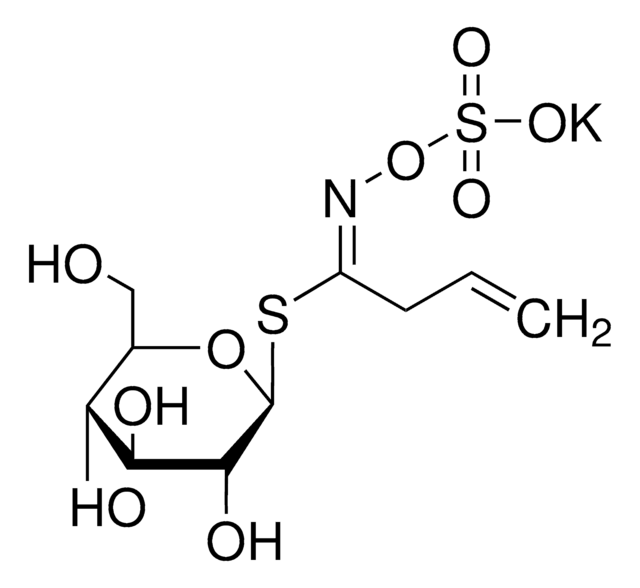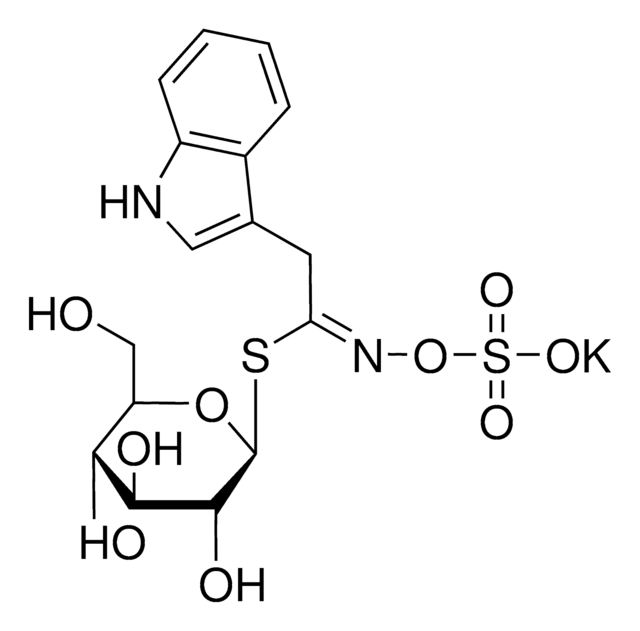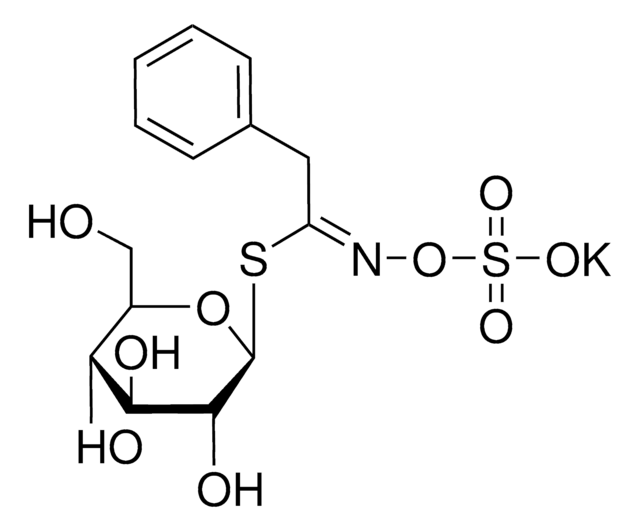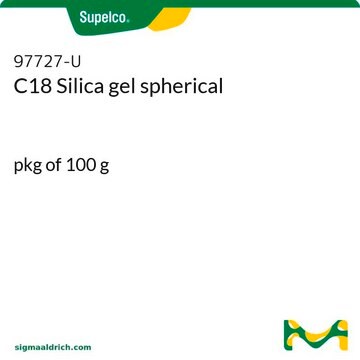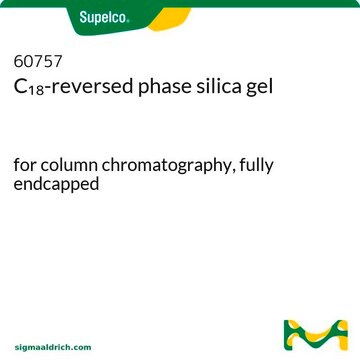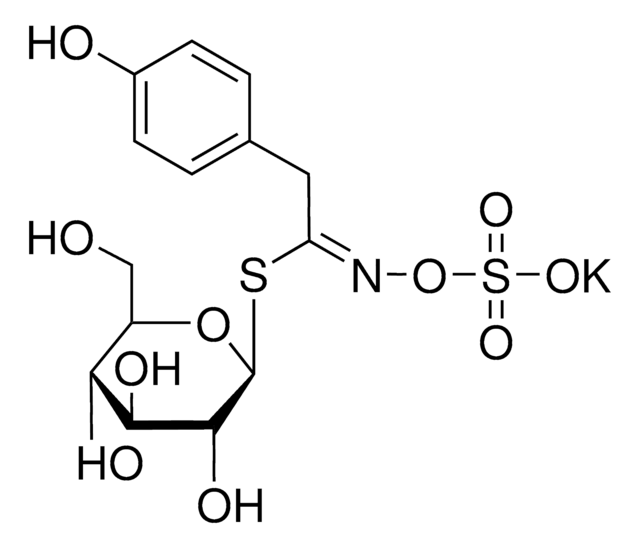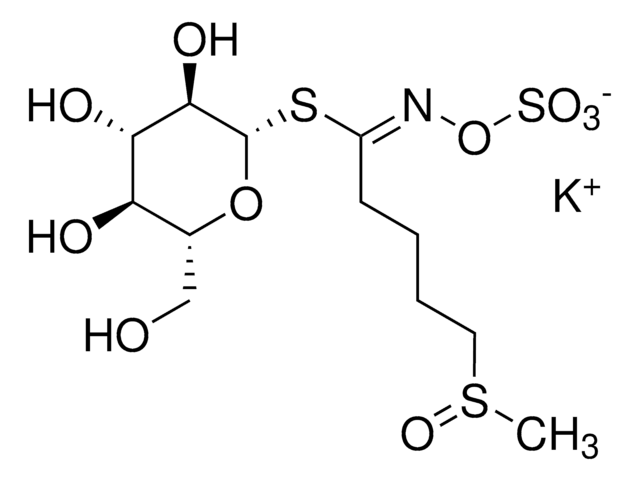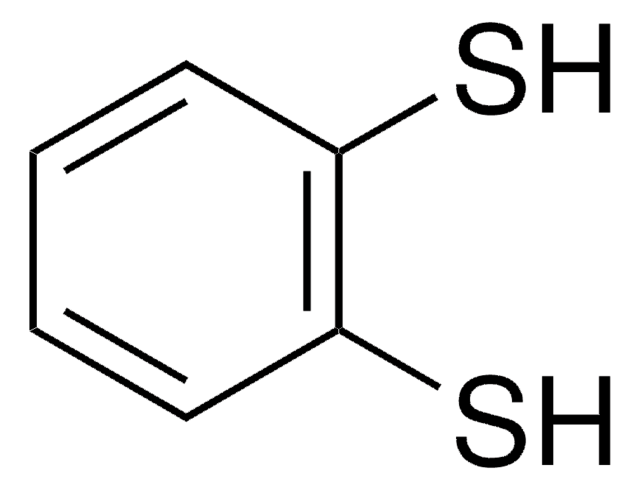추천 제품
관련 카테고리
일반 설명
Thioglucosidase, also called as myrosinase, is present in the myrosin cells that do not contain glucosinolates. This enzyme is obtained from several plant sources, such as Lepidium sativum, L. Sinapis alba and Brassica napus.
애플리케이션
Thioglucosidase from Sinapis alba (white mustard) seeds has been used as a standard to quantify myrosinase activity and in column glucosinolate analysis of plant samples.
Thioglucosidase has been used in a study to assess Brassica species screening for glucosinolate content. Thioglucosidase has also been used in a study to investigate a negative regulatory role for auxin in sulphate deficiency response in Arabidopsis thaliana.
생화학적/생리학적 작용
Myrosinases are present in many bacteria, fungi, and edible plants, including those of the Brassicaceae (Cruciferae) family. The enzyme hydrolyzes the S-glucosidic bond of a glucosinolate substrate to form an unstable aglycone that rearranges with the loss of sulfate primarily to the isothiocyanate, though thiocyanates and nitriles are also formed. Many of the isothiocyanate products of aliphatic and aromatic glucosinolates have cancer chemopreventive properties.
Thioglucosidase research has focused mainly on the cruciferous crops due to their economic importance and cancer preventive benefits.
단위 정의
One unit will produce 1.0 μmole glucose per min from sinigrin at pH 6.0 at 25 °C.
신호어
Danger
유해 및 위험 성명서
예방조치 성명서
Hazard Classifications
Resp. Sens. 1
Storage Class Code
11 - Combustible Solids
WGK
WGK 3
Flash Point (°F)
Not applicable
Flash Point (°C)
Not applicable
개인 보호 장비
Eyeshields, Gloves, type N95 (US)
이미 열람한 고객
Wei Chen et al.
Frontiers in physiology, 13, 1013092-1013092 (2022-11-08)
Glycoside hydrolase family 1 (GH1) members exhibit a broad substrate spectrum and play important roles in insect-plant interactions, such as the defensive β-glucosidase and β-thioglucosidase (so-called myrosinase). However, knowledge about the expression profiling and function of glycoside hydrolase family 1
Niels Agerbirk et al.
Phytochemistry, 153, 79-93 (2018-06-11)
Glucosinolates are found in plants of the order Brassicales and hydrolyzed to different breakdown products, particularly after tissue damage. In Barbarea vulgaris R.Br. (Brassicaceae), the dominant glucosinolate in the investigated "G-type" is glucobarbarin, (S)-2-hydroxy-2-phenylethylglucosinolate. Formation of the nitrile from glucobarbarin
Teresa Oliviero et al.
Molecular nutrition & food research, 62(18), e1700837-e1700837 (2018-03-14)
Optimization of bioavailability of dietary bioactive health-beneficial compounds is as important as increasing their concentration in foods. The aim of this study is to explore the change in bioavailability of isothiocyanates (ITCs) in broccoli sprouts incorporated in protein, fiber, and
Patricia A Egner et al.
Cancer prevention research (Philadelphia, Pa.), 4(3), 384-395 (2011-03-05)
One of several challenges in design of clinical chemoprevention trials is the selection of the dose, formulation, and dose schedule of the intervention agent. Therefore, a cross-over clinical trial was undertaken to compare the bioavailability and tolerability of sulforaphane from
Shikha Saha et al.
Molecular nutrition & food research, 56(12), 1906-1916 (2012-10-31)
Sulforaphane (a potent anticarcinogenic isothiocyanate derived from glucoraphanin) is widely considered responsible for the protective effects of broccoli consumption. Broccoli is typically purchased fresh or frozen and cooked before consumption. We compared the bioavailability and metabolism of sulforaphane from portions
자사의 과학자팀은 생명 과학, 재료 과학, 화학 합성, 크로마토그래피, 분석 및 기타 많은 영역을 포함한 모든 과학 분야에 경험이 있습니다..
고객지원팀으로 연락바랍니다.

